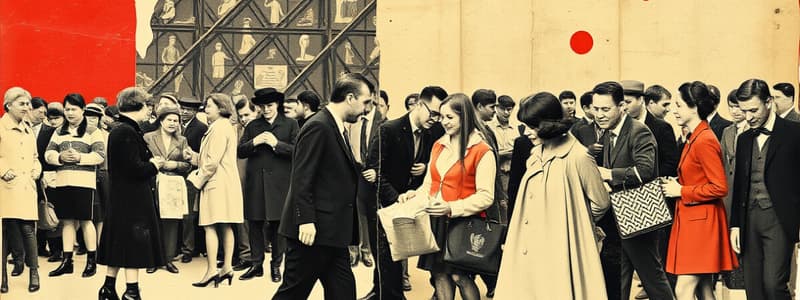Podcast
Questions and Answers
What is social class?
What is social class?
- Based only on race
- An unchanging hierarchy
- A system based on religion
- The stratification system in modern industrial societies (correct)
What are class systems based on?
What are class systems based on?
- Economic factors (correct)
- Race and religion
- Fixed hierarchies
- None of the above
Why do sociologists want to measure social class?
Why do sociologists want to measure social class?
To address class differences and identify reasons for inequalities.
What is the significance of occupation as an indicator of social class?
What is the significance of occupation as an indicator of social class?
What is the registrar general's scale based on?
What is the registrar general's scale based on?
What is a criticism of the registrar general's scale?
What is a criticism of the registrar general's scale?
What did the Hope Goldthorpe scale acknowledge?
What did the Hope Goldthorpe scale acknowledge?
What does the Surrey occupational class schema attempt to do?
What does the Surrey occupational class schema attempt to do?
What has been criticized about the Hope Goldthorpe scale?
What has been criticized about the Hope Goldthorpe scale?
Flashcards are hidden until you start studying
Study Notes
Social Class and Class Systems
- Social class refers to the stratification in modern industrial societies, characterized by shared economic conditions, occupations, income, education, status, and power.
- Class systems are not determined by race or religion, but rather economic factors like education and wealth; they grant equal rights regardless of social position.
- Open societies allow individuals to move within the class structure based on achievements, job opportunities, or marriage, promoting meritocracy and self-improvement.
Reasons to Measure Social Class
- Sociologists aim to understand and address class differences in social life to explore the origins of inequalities.
- Advertisers target specific social groups to enhance sales, while governments create policies to combat existing inequalities.
Occupation as an Indicator
- Occupation impacts income, housing, and education levels, influencing lifestyle and identity.
- It acts as a significant indicator of an individual's wealth and social position.
- Criticism arises as this measure excludes those who do not work, such as the extremely wealthy and long-term unemployed, complicating objective assessments of social class.
Registrar General's Scale
- Utilized by the government from 1911-2000 to classify thousands of jobs into six classes based on the occupational skill of the household head.
- Classification includes:
- Professional
- Lower managerial, professional, and technical
- Skilled non-manual
- Skilled manual
- Semi-skilled manual
- Unskilled manual
- Differentiation between middle class (1-3) and working class (4-6) serves as a basis for important social surveys, especially concerning educational achievement and life expectancy.
Criticisms of the Registrar General's Scale
- Bias in job assessments favored non-manual occupations over manual ones.
- The system inadequately recognized individuals who do not work, classifying unemployed based on their last job.
- Feminist critiques highlight sexism in class assignment, reducing women to their husband's occupational status.
Hope Goldthorpe Scale
- Responded to the evolving middle class, factoring in market position (income and economic opportunities).
- Acknowledges shared experiences between manual and non-manual sectors by forming an intermediate class.
- Introduced three main social divisions: service class, intermediate class, and working class, reflecting the complexities of the British class system while still primarily based on the male head of household.
Feminist Critiques of the Hope Goldthorpe Scale
- Fails to consider the impact of dual career families, where combined incomes elevate social status.
- Ignores women in higher-status occupations and single working parents classified by partners' or fathers' occupations.
Surrey Occupational Class Schema
- Designed to address patriarchal bias by classifying women based on their occupations, regardless of marital status.
- Incorporates the gendered nature of work but faces challenges with certain employment classifications.
Studying That Suits You
Use AI to generate personalized quizzes and flashcards to suit your learning preferences.




